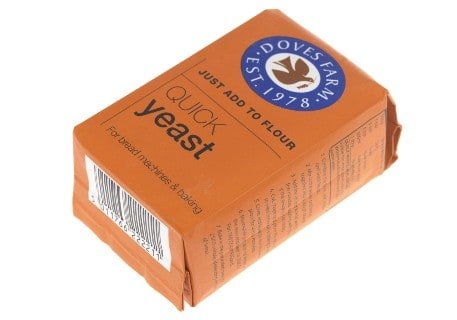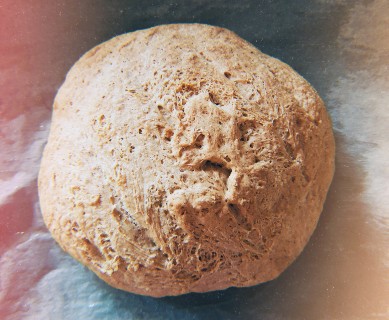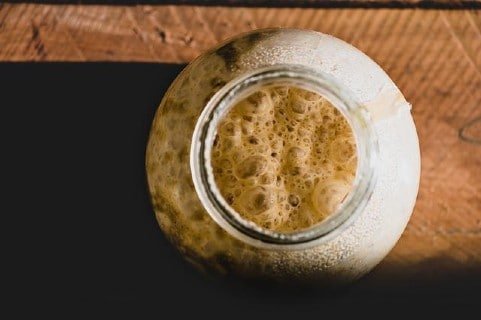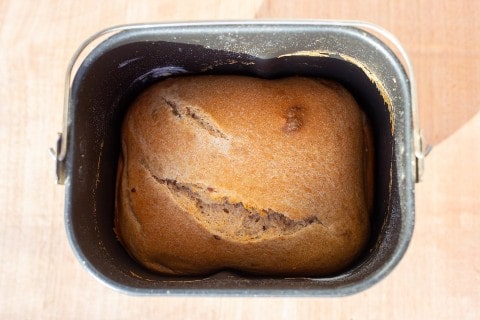Bread machine yeast is specially made to work in bread machines. It’s a packaged product that is ready to use and doesn’t require any sort of proofing to be prepared. The idea is that bread machines quickly make bread for you right from mixing ingredients to baking the loaf.
So what is bread machine yeast and can you use just any yeast you have on hand? Bread machine yeast is manufactured keeping in mind that there is no proofing step at the beginning as there is for regular or active dry yeast to activate. It can activate without any water addition and can work faster than active dry yeast. It will cause the dough to rise in a closed environment. This produces bread identical in taste and texture to hand-made bread baked in the oven if you used regular yeast.
Table of Contents
What is Bread Machine Yeast?
Bread machine yeast is a type of instant yeast that is primed to be used inside a bread machine. It chemically and visually differs from regular yeast and is much faster acting so that the mixed dough rises faster. The granules are finer and it’s completely dry and packaged to retain its freshness so you can use it well after it has been packed but you can extend its life even more by refrigerating it.
Regular yeast is made to work with water before the whole mixture is added to the rest of the ingredients. You would use this yeast if you were making dough using a stand mixer instead of a bread machine. However, modern-day active dry yeast can be used without proofing; just don’t expect your dough to rise fast. It does not lose its verve and potency over time and can last years in dry conditions. Fresh yeast has higher water content and loses potency over time, so it can’t be kept for too long. It also needs proofing before use.
Does Bread Machine Yeast Need to be Proofed?
Bread machine yeast does not need to be proofed. Proofing or blooming yeast means mixing it with water to activate it so that the gas that’s released is what makes bread dough rise before baking. Bread machine yeast is made to work in closed conditions inside the bread machine. Therefore it can be put in completely dry.
Does Bread Machine Yeast Need to be Refrigerated?
Bread machine yeast is best kept at room temperature or lower and in a dry environment until it’s opened. Once you open the packet, store the remaining amount in the fridge or freezer in an airtight container. This way, refrigeration can increase its lifespan, or at least stretch its potency till its expiration date. Otherwise, bread machine yeast can expire before its time in warm and humid conditions.
How Long is Bread Machine Yeast Good For?
Bread machine yeast is often good for months after opening. Average expiration dates range from 3-4 months after opening. However, know that the expiration date is usually standardized for storage at room temperature, which is usually 70-77 F.
If the yeast is stored above this temperature, then the yeast will spoil more quickly. It may go bad within 1-2 months. If you store yeast in a freezer, however, you can make it last for many months longer. Just make sure to protect the yeast from moisture. This way, you can stretch its lifespan by a few months more. In fact, freezer storage can actually increase yeast’s lifespan from 6 months to a full year.
How is Bread Machine Yeast Different From Regular Yeast?
Bread machine yeast differs from regular yeast in one singular aspect. It doesn’t require water to activate. Bread machine yeast is usually dry and looks like fine granules. Yes, it does benefit from higher temperatures. However, it doesn’t require proofing. Bread machine yeast is made so that it can be added to all the rest of the ingredients at the same time, with the proofing or rising of the dough happening after the first kneading cycle. Here is a guide on the different cycles that a bread machine goes through.

Bread Machine Yeast Vs Instant Yeast and Rapid Rise Yeast
While instant yeast/rapid rise yeast and bread machine yeast can all be used in bread machines, they’re different in action. Instant yeast or rapid rise yeast is meant to bake bread within smaller time windows. These types of yeast are best suited to the rapid rise cycle settings in the bread machine. If you don’t use the rapid rise cycle, you’re in danger of damaging your machine or increasing the pressure inside. You may also notice the final product develop a sunken top after you take it out of the machine.
Bread machine yeast works best on the normal cycle of the machine.
Bread Machine Yeast Vs Active Dry Yeast
Active dry yeast and bread machine yeast are made differently. Regular or active dry yeast requires proofing or mixing with water to activate it. However, bread machine yeast doesn’t require this step.
How to Use Bread Machine Yeast
Here is how you can use bread machine yeast to make bread:
- Gather All the Ingredients
- Sugar
- Salt
- Butter
- Milk
- Bread Flour
- Bread Machine Yeast
- Heat Milk and Pour In
- Add the Rest of the Ingredients
- 2 tbsp Butter
- 2 tbsp Sugar (sugar is what the yeast eats to make more bubbles, which makes the dough rise more)
- 1 tsp Salt
- 3 cups of Bread Flour
- 1 ½ tsp of Bread Machine Yeast
- Start the Baking Cycle
- Serve the Bread
You’ll need these ingredients to bake bread the right way:

Heat the milk to about 80 F. This will ensure that the milk has enough heat to begin the baking process immediately. This will help the dry yeast activate faster. Then pour it into the bread machine canister.
Then put the canister into the bread machine and close the lid. Then set it to the standard cycle. Your bread will take 3-3.5 hours to bake. If you want bread faster, then choose the rapid rise cycle, which will finish within 2 hours maximum.
About 5 minutes into the cycle, you should check whether all the flour and ingredients have mixed. If any residue is left on the sides of the canister, you can use a small spatula to scrape it off and mix it into the dough.
After the baking cycle is over, you can take out the canister and serve the hot bread.
Notes for Baking Bread in a Bread Machine:
If the dough isn’t rising, you can save it by introducing a fresh sample of active dry yeast. Instant or rapid rise yeast will work as well. Note that this will not give you the best flavor since it’s a delayed reaction. However, your bread will be “saved” in the sense that the dough will rise and expand.
Can Bread Machine Yeast be Used for Regular Baking?
With certain limitations, you can use bread machine yeast for regular baking when you’re hand kneading the dough, using a food processor with dough blades, or using a stand mixer with dough hooks. This yeast doesn’t need water to be activated. Hence, it will react with the dough without moisture. However, know that bread machine yeast works better in controlled conditions and compact environments. It probably won’t give you the exact desired result as with bread machines. Also, regular yeast will cost you much less.
Do You Have to Use Bread Machine Yeast in a Bread Machine?
Bread machine yeast is specially formulated to work in the controlled environment of the machine and without added water, so you’ll get the best results in terms of taste and texture if you use it for making bread in a machine. However, it is the most expensive type of yeast and may not be available in all stores, so you can use substitutions.
Can You Use Quick Rise Yeast in a Bread Machine?
Quick rise yeast also contains some dough conditioner like ascorbic acid to make the bread rise even quicker. You can use quick or rapid rise yeast instead of bread machine yeast and set the machine to the rapid cycle.
Can I Use Dry Active Yeast in a Bread Machine?
If bread machine or even rapid rise yeast isn’t available, you can use active dry yeast but you should multiply the quantity by 1.25 because its granules are larger. First mix it with water and let it proof before adding it to the canister and use the normal cycle.
How to Test if Yeast is Active
The reason you may even need to test if yeast is active is that expired yeast works slower or not at all. The bread you’re making may go completely to waste if you don’t perform this test first.

Yeast packets often come with expiration dates and you should use them before the date arrives because it’s an organism that loses its properties beyond that date.
To test if yeast is active, sprinkle a little onto 125 mm of lukewarm water and mix. Then wait a little while for the yeast to dissolve and bubbles to start forming. If there are no bubbles, your yeast is useless. The water shouldn’t be cold, or you won’t get the right result. It shouldn’t be too warm either or the yeast will be killed.
How Much Yeast is in a Packet?
A packet of yeast usually contains as little as 7 grams of the product in total. You don’t need much of it to bake a single batch of bread. Several recipes call for a single packet of yeast without even mentioning the exact amount.
These packets contain dried, active yeast which makes them very easy to use. If you don’t have a packet of yeast and instead have stored it in a jar, then 2 ¼ teaspoons will work.
You can get any type of yeast in a packet depending on what you’re cooking. This could be baker’s yeast which is the most well suited for bread. It could also be nutritional yeast for any more nutritious products. You could also get brewer’s or wine yeast if you’re brewing up some alcoholic beverages.


